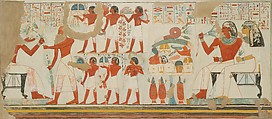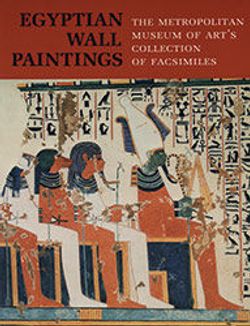Offerings Made to the Deceased and his Wife, Tomb of Djehutyemheb
Twentieth Century; original New Kingdom, Ramesside
Scenes of the deceased seated at an offering table or receiving offerings of food from their children represent the outcome of Egyptian funerary rites. The dead have achieved blessed status through ritual, and now receive the sustenance that allows them to survive eternally.
The eldest son was responsible for the funeral and cult of the deceased. To the left, the eldest son of Djehutyemhab extends a tall bouquet to his father, whose image is only partly preserved. Other children follow bringing fruit, fish, birds, and a small calf.
On the right, Djehutyemhab and his wife, Baketkhonsu, are seated before an offering table.
Djehutyemhab took over an unfinished tomb from an earlier owner. Here, the earlier multicolored hieroglyphs contrast with Djehutyemhab’s simple red additions.
Due to rights restrictions, this image cannot be enlarged, viewed at full screen, or downloaded.


